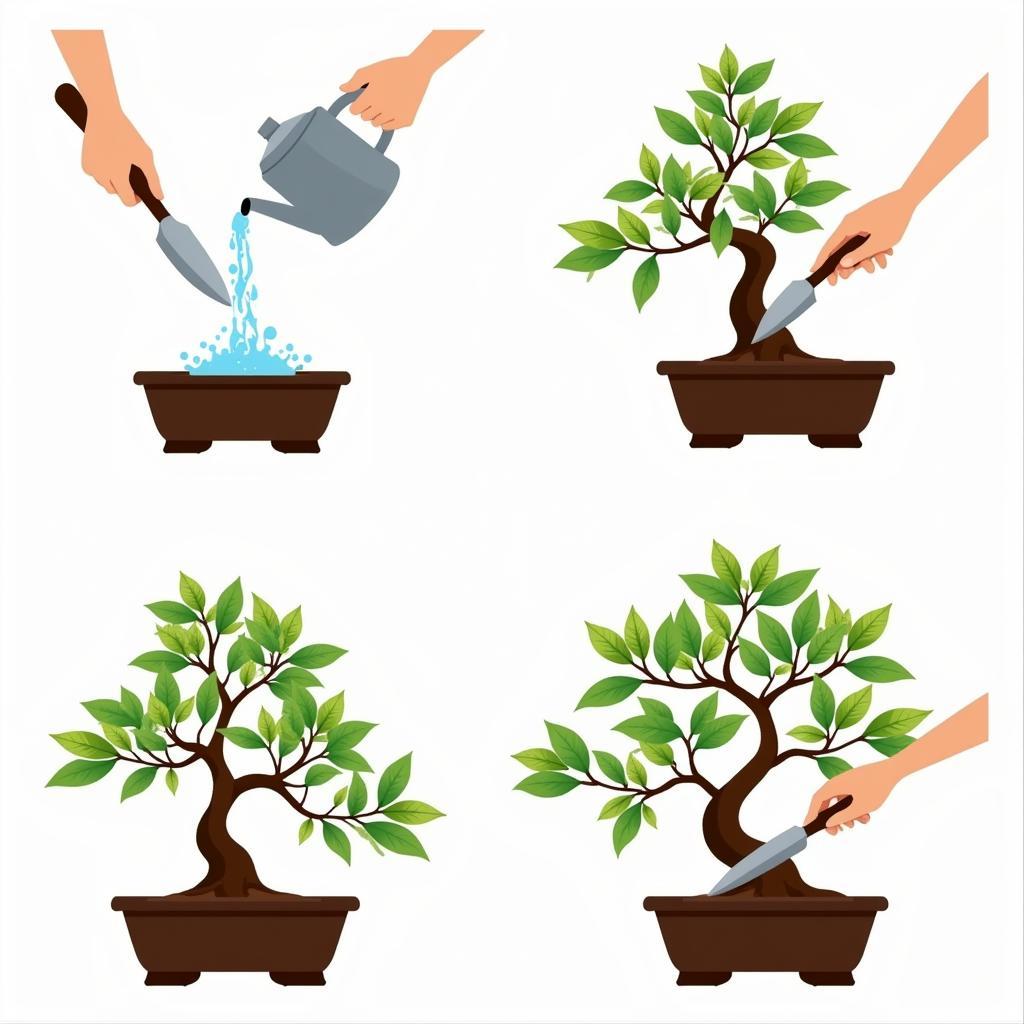Black Cherry Bonsai trees offer a captivating blend of delicate beauty and the strength of nature, miniaturized into an art form. These stunning trees, prized for their bark, foliage, and potential to bear fruit, are a rewarding challenge for bonsai enthusiasts. Whether you’re a seasoned bonsai grower or just starting your journey, understanding the nuances of caring for a black cherry bonsai is key to unlocking its full potential.
Exploring the Allure of Black Cherry Bonsai
Black cherry bonsai, scientifically known as Prunus serotina, brings the grandeur of a full-sized cherry tree into the confines of a pot. Their dark, textured bark contrasts beautifully with the vibrant green leaves, creating a visually striking miniature landscape. Beyond their aesthetic appeal, these bonsai trees offer a unique connection to the natural world, allowing you to cultivate and shape a living piece of art. The potential for fragrant blossoms and even small, edible cherries adds another layer of intrigue to these fascinating trees.
Caring for Your Black Cherry Bonsai: A Comprehensive Guide
Proper care is essential for ensuring the health and longevity of your black cherry bonsai. These trees thrive in specific conditions and require regular attention to detail. Here’s a breakdown of the key elements to consider:
- Sunlight: Black cherry bonsai require ample sunlight, ideally 6-8 hours per day. Place your tree in a location that receives direct sunlight, especially during the growing season.
- Watering: Water your black cherry bonsai thoroughly when the top inch of soil feels dry. Avoid overwatering, which can lead to root rot. Ensure proper drainage to prevent waterlogging.
- Soil: Use a well-draining bonsai soil mix that provides adequate aeration and nutrients. A mixture of akadama, pumice, and lava rock is a good option.
- Fertilizing: Feed your black cherry bonsai with a balanced liquid fertilizer during the growing season (spring and summer). Reduce or stop fertilizing during the dormant period (fall and winter).
- Pruning: Regular pruning is essential for shaping and maintaining the desired form of your bonsai. Prune new growth to encourage branching and maintain a compact size.
- Repotting: Repot your black cherry bonsai every 2-3 years to refresh the soil and prevent rootbound conditions. This is best done in early spring before the growing season begins.
 Black Cherry Bonsai Care Guide
Black Cherry Bonsai Care Guide
Styling Your Black Cherry Bonsai: Unleashing Your Creativity
The art of bonsai lies in shaping and styling the tree to create a miniature representation of nature. With black cherry bonsai, you have a variety of styling options to explore. Formal upright, informal upright, slanting, and cascading styles are all popular choices. Use wiring techniques to guide the branches and create the desired shape.
- Formal Upright: This style features a straight trunk with evenly spaced branches, creating a symmetrical and balanced appearance.
- Informal Upright: This style allows for more natural curves and bends in the trunk, mimicking the growth patterns of trees in nature.
- Slanting: This style creates a dramatic effect with a trunk that leans to one side, often suggesting a tree enduring strong winds.
- Cascading: This style is characterized by branches that cascade down below the rim of the pot, resembling a tree growing on a cliffside.
“Choosing the right style for your black cherry bonsai depends on the natural characteristics of the tree and your personal aesthetic preferences,” says renowned bonsai artist, Dr. Emily Carter. “The beauty of bonsai lies in the ability to express your artistic vision through the living medium of a tree.”
Troubleshooting Common Black Cherry Bonsai Problems
Like any living organism, black cherry bonsai can be susceptible to pests and diseases. Here are some common problems to watch out for:
- Aphids: These tiny insects can infest the leaves and stems, sucking the sap and weakening the tree. Treat with insecticidal soap or neem oil.
- Spider Mites: These pests can cause yellowing and stippling of the leaves. Increase humidity and use a miticide if necessary.
- Leaf Spot: This fungal disease can cause brown spots on the leaves. Remove affected leaves and improve air circulation.
“Prevention is key when it comes to protecting your black cherry bonsai from pests and diseases,” advises Dr. Carter. “Maintaining proper hygiene, providing adequate sunlight and ventilation, and avoiding overwatering are crucial for preventing problems.”
Conclusion: Embracing the Art of Black Cherry Bonsai
Black cherry bonsai offers a unique and rewarding experience for bonsai enthusiasts of all levels. By understanding the specific needs of these beautiful trees and applying proper care techniques, you can cultivate a thriving miniature masterpiece that brings the beauty of nature into your home. With patience, dedication, and a touch of artistic flair, you can unlock the full potential of your black cherry bonsai and enjoy the tranquility of this ancient art form.
FAQ
- How often should I water my black cherry bonsai?
- What type of soil is best for black cherry bonsai?
- How do I prune my black cherry bonsai?
- When should I repot my black cherry bonsai?
- What are some common pests and diseases that affect black cherry bonsai?
- What are the different styling options for black cherry bonsai?
- How much sunlight does a black cherry bonsai need?
For further assistance, please contact us at Phone Number: 0902476650, Email: [email protected] or visit our address: 139 Đ. Võ Văn Kiệt, Hoà Long, Bà Rịa, Bà Rịa – Vũng Tàu, Việt Nam. We have a 24/7 customer support team.





